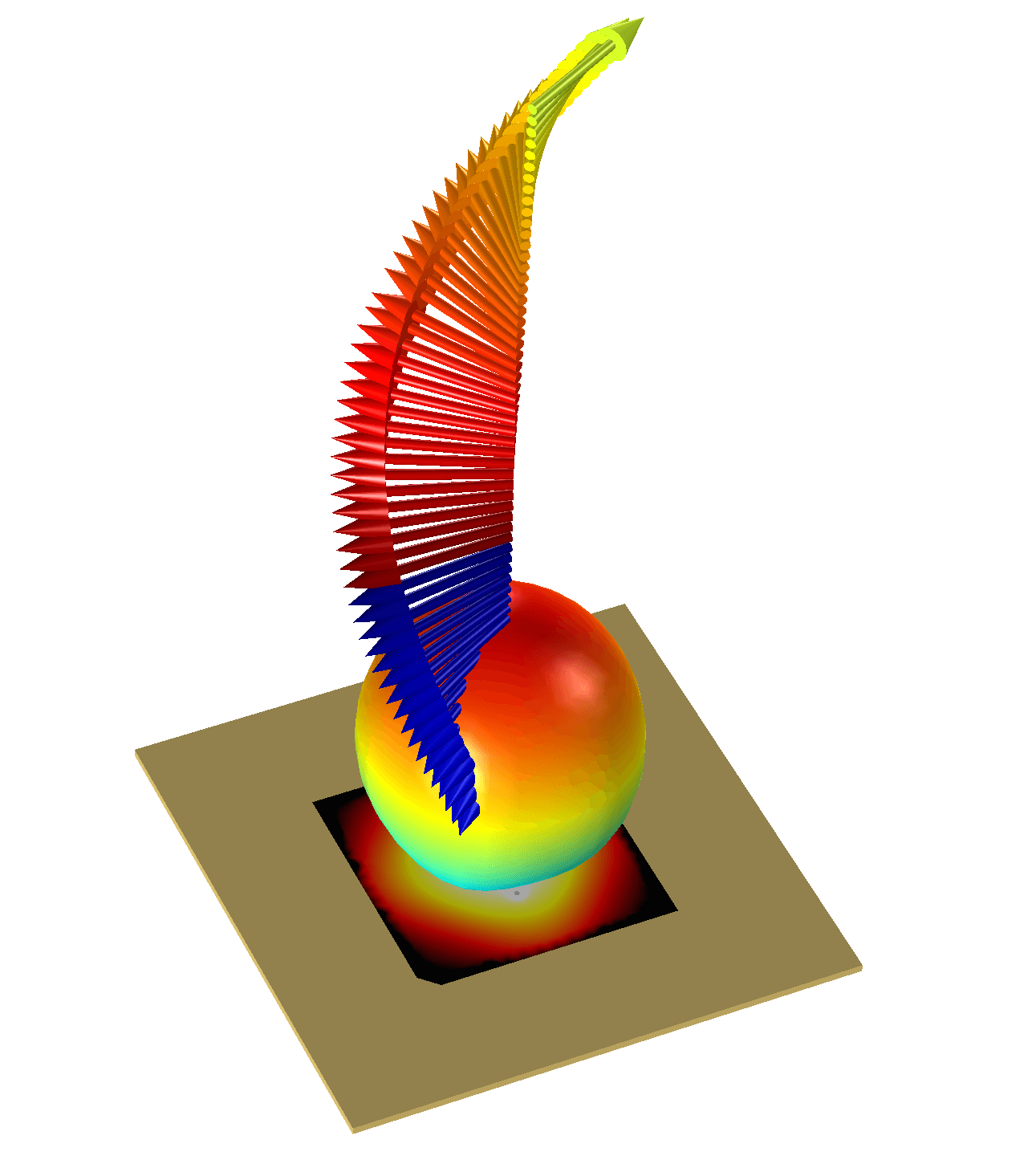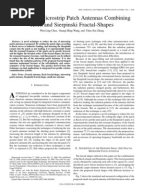Micro Strip Patch Antenna Primer
Micro strip Patch Antenna and its Applications: a Survey. Indrasen Singh, Dr. Motilal Nehru National Institute of Technology Allahabad. Download Micro strip Patch Antenna Primer Download free online book chm pdf.
Hello, For designing the patch antenna for 60 GHz, you need to consider few things e.g. Feeding, thickness and bandwidth. To begin with you can design the patch for f = 60 GHz using the formula given in Balanis. You can use inset feeding, coaxial feeding or aperture couple feeding for the patch.
Once you design the patch and feeding according to the formula, you can then fine tune it in any EM solver for your specific needs. If you need a ready made solution then you can use Antenna Magus software for the designing.


Regards Praful. @prafuldeo I found a feeding network for 2x2 array at 60 GHz.The image is attached below.I have few questions. 1) The feed network shown is not using 100 Ohms for matching. It only uses 50 and 70 (QWT) ohm.Is this matching correct? If so can you explain how so?
2) Could you tell me how to get those bends in CST simulator? 3) And what should be the ideal spacing between elements? Rule of thumb is Lambda/2 (which in case of 60 GHz = 5mm/2 = 2.5mm) but the paper mentions 6.5mm. Isn;t it wrong? Awaiting replies Regards.
Diagram of the feed structure of a microstrip antenna array. In, a microstrip antenna (also known as a printed antenna) usually means an fabricated using techniques on a (PCB). They are mostly used. An individual microstrip antenna consists of a patch of metal foil of various shapes (a ) on the surface of a PCB, with a metal foil on the other side of the board. Most microstrip antennas consist of multiple patches in a two-dimensional array.
The antenna is usually connected to the or through foil. The current is applied (or in receiving antennas the received signal is produced) between the antenna and ground plane.
Circular Microstrip Patch Antenna
Microstrip antennas have become very popular in recent decades due to their thin planar profile which can be incorporated into the surfaces of consumer products, aircraft and missiles; their ease of fabrication using techniques; the ease of integrating the antenna on the same board with the rest of the circuit, and the possibility of adding active devices such as to the antenna itself to make. Main article: The most common type of microstrip antenna is the. Antennas using patches as constitutive elements in an array are also possible. A patch antenna is a narrowband, wide- antenna fabricated by etching the antenna element pattern in metal trace bonded to an insulating substrate, such as a, with a continuous metal layer bonded to the opposite side of the substrate which forms a.
Common microstrip antenna shapes are square, rectangular, circular and elliptical, but any continuous shape is possible. Some patch antennas do not use a dielectric substrate and instead are made of a metal patch mounted above a ground plane using dielectric spacers; the resulting structure is less rugged but has a wider. Because such antennas have a very low profile, are mechanically rugged and can be shaped to conform to the curving skin of a vehicle, they are often mounted on the exterior of aircraft and spacecraft, or are incorporated into communications devices. Advantages Microstrip antennas are relatively inexpensive to manufacture and design because of the simple 2-dimensional physical geometry. They are usually employed at and higher frequencies because the size of the antenna is directly tied to the at the. A single patch antenna provides a maximum directive gain of around 6-9. It is relatively easy to print an array of patches on a single (large) substrate using lithographic techniques.
Patch arrays can provide much higher gains than a single patch at little additional cost; matching and phase adjustment can be performed with printed microstrip feed structures, again in the same operations that form the radiating patches. The ability to create high gain arrays in a low-profile antenna is one reason that patch arrays are common on airplanes and in other military applications.
Such an array of patch antennas is an easy way to make a of antennas with dynamic ability. An advantage inherent to patch antennas is the ability to have diversity. Patch antennas can easily be designed to have vertical, horizontal, right hand circular (RHCP) or left hand circular (LHCP) polarizations, using multiple feed points, or a single feedpoint with asymmetric patch structures. This unique property allows patch antennas to be used in many types of communications links that may have varied requirements. Rectangular patch The most commonly employed microstrip antenna is a rectangular patch which looks like a truncated transmission line.
It is approximately of one-half wavelength long. When air is used as the dielectric substrate, the length of the rectangular microstrip antenna is approximately one-half of a free-space. As the antenna is loaded with a dielectric as its substrate, the length of the antenna decreases as the relative of the substrate increases. The resonant length of the antenna is slightly shorter because of the extended electric 'fringing fields' which increase the electrical length of the antenna slightly. An early model of the microstrip antenna is a section of microstrip transmission line with equivalent loads on either end to represent the radiation loss. Specifications The dielectric loading of a microstrip antenna affects both its radiation pattern and impedance bandwidth.
As the dielectric constant of the substrate increases, the antenna bandwidth decreases which increases the of the antenna and therefore decreases the impedance bandwidth. This relationship did not immediately follow when using the transmission line model of the antenna, but is apparent when using the cavity model which was introduced in the late 1970s by Lo et al. The radiation from a rectangular microstrip antenna may be understood as a pair of equivalent slots. These slots act as an array and have the highest directivity when the antenna has an air dielectric and decreases as the antenna is loaded by material with increasing relative dielectric constant.
The half-wave rectangular microstrip antenna has a virtual shorting plane along its center. This may be replaced with a physical shorting plane to create a quarter-wavelength microstrip antenna. This is sometimes called a half-patch. The antenna only has a single radiation edge (equivalent slot) which lowers the directivity/gain of the antenna. The impedance bandwidth is slightly lower than a half-wavelength full patch as the coupling between radiating edges has been eliminated. Other types Another type of patch antenna is the (PIFA).
The PIFA is common in cellular phones (mobile phones) with built-in antennas. The antenna is resonant at a quarter-wavelength (thus reducing the required space needed on the phone), and also typically has good SAR properties. This antenna resembles an inverted F, which explains the PIFA name. The PIFA is popular because it has a low profile and an omnidirectional pattern. These antennas are derived from a quarter-wave half-patch antenna. The shorting plane of the half-patch is reduced in length which decreases the resonance frequency.
Often PIFA antennas have multiple branches to resonate at the various cellular bands. On some phones, grounded parasitic elements are used to enhance the radiation bandwidth characteristics. The (FICA) has some advantages with respect to the PIFA, because it allows a better volume reuse. Nowadays, a new version of microstrip antenna with partially etched ground plane has come up. It is also popularly known as printed monopole antennas. They have very broad bandwidth unlike mircostrip antennas. References.
Lee, Kai Fong,; Luk, Kwai Man (2011). World Scientific. by Louis E. Frenzel, 'Electronic Design' 2008. Bancroft, R. Microstrip and Printed Antenna Design Noble Publishing 2004, chapter 2-3. Lo, Y.T., Solomon D.
And Richards, W.F. 'Theory and Experiment on Microstrip Antennas,' IEEE Transactions on Antennas and Propagation, AP-27, 1979 pp. Iulian Rosu. Tsunekawa, K. And Saski, A., 'Antennas for Detachable Mobile Radio Units,' Review of the ECL, NTT, Japan, Vol. 35, No.1, January 1987, pp. at antenna-theory.com.
Di Nallo, C.; Faraone, A., 'Multiband internal antenna for mobile phones,' Electronics Letters, vol.41, no.9, pp. 514-515, 28 April 2005. M. Gogoi, 'Printed Monopole Antenna with Tapered Feed Line, Feed Region and Patch for Super Wideband Applications,' IET Microwaves, Antennas and Propagation, vol.
39-45, January 2014 External links. antenna-theory.com. EM Talk.